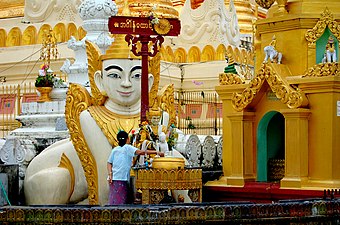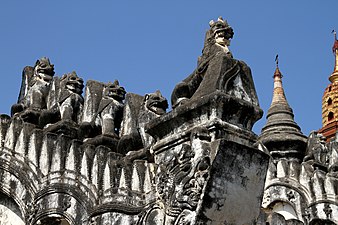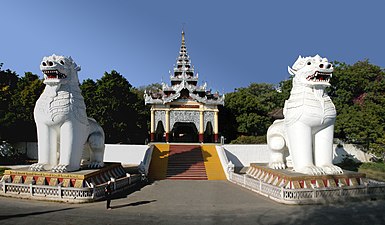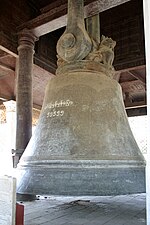Chinthe
The chinthe ( Burmese : ခြင်္ သေ့, IPA: tɕʰɪ̀ɰ̃ðḛ; Mon language : ဇါ ဒိ သိုၚ်, IPA: cɛ̀atìʔsaŋ; Shan language : သၢင်ႇ သီႈ, IPA: sàːŋ si) is a highly stylized leogryph ( lion- like creature) that is used in Burmese iconography and architecture Myanmar is often depicted, particularly as a pair of guardians flanking the entrances to Buddhist pagodas and kyaung (or Buddhist monasteries). The chinthe is featured prominently on most kyat banknotes . A related creature to the Manussiha, is also frequently depicted in Myanmar. In Burmese, chinthe is synonymous with the Burmese word for "lion".
The chinthe is related to other leogryphs in the Asian region, including the sing (สิงห์) from Thailand , Cambodia , Laos and the simha (සිංහ) from Sri Lanka , where it is prominently represented on the Sri Lankan rupee . It is also related to East Asian leogryphs, such as the Chinese guardian lions , the Japanese Komainu lions, the Japanese Shisa lions of Okinawa, and the Tibetan snow lions .
Origins
The story of why Chinthe guard the entrances to pagodas and temples is told as such in a legend: A princess had a son by marrying a lion, but later left the lion, who then became angry and terrorized the land. The son set out to kill the lion. When he found the lion, he shot an arrow at him, but the lion's unshakable love for his son was so great that the arrow ricocheted off the lion's forehead and fell to the ground at the boy's feet. This happened three times. But then the lion became angry; and when the boy made the fourth arrow fly, he pierced the lion and killed him. Thus the Leo lost his life because he had lost his self-control and let anger penetrate his heart. The son came back to his mother's home and stated that he had killed the lion and then found out that he had killed his own father. The son later erected a statue of the lion as a guardian of a temple to atone for his sin.
In Burmese culture
The chinthe is used symbolically as an element of Burmese iconography on many revered objects, including the palin , the Burmese royal thrones , and the Burmese bells. Before coins were used for money, brass weights were commonly cast in the shape of mythical beasts such as the chinthe to measure standard quantities of everyday items. In the Burmese zodiac, the chinthe (lion) sign is representative of people born on Tuesday.
A line of Chinthen flank the roof of the Ananda Temple in Bagan.
A pair of whitewashed chinthe guard the entrance to Mandalay Hill .
Chinthe are often depicted on Burmese bells, including the Mingun bell .
Manussiha
The Manussiha (Burmese: မ နု ဿီ ဟ} manothiha , Shan language: မ ၼုၵ်ႉ သႉ သီႇ ႁႃႉ manuk siha ), a combination of Pali manussa (human) and siha (lion) is a mythical half-human-half-lion symbol that stands for a guardian who usually covers the four corners guarded by a pagoda. It has a human head and torso and a lion rump. It is comparable to the Sphinx and the Hindu deity Narasimha .
Individual evidence
- ↑ Shwedagon Paya, Rangoon . Retrieved April 3, 2020.
- ↑ Image 5 of 20 . Retrieved April 3, 2020.
- ↑ Archived copy . Archived from the original on February 27, 2009. Retrieved April 3, 2020.








